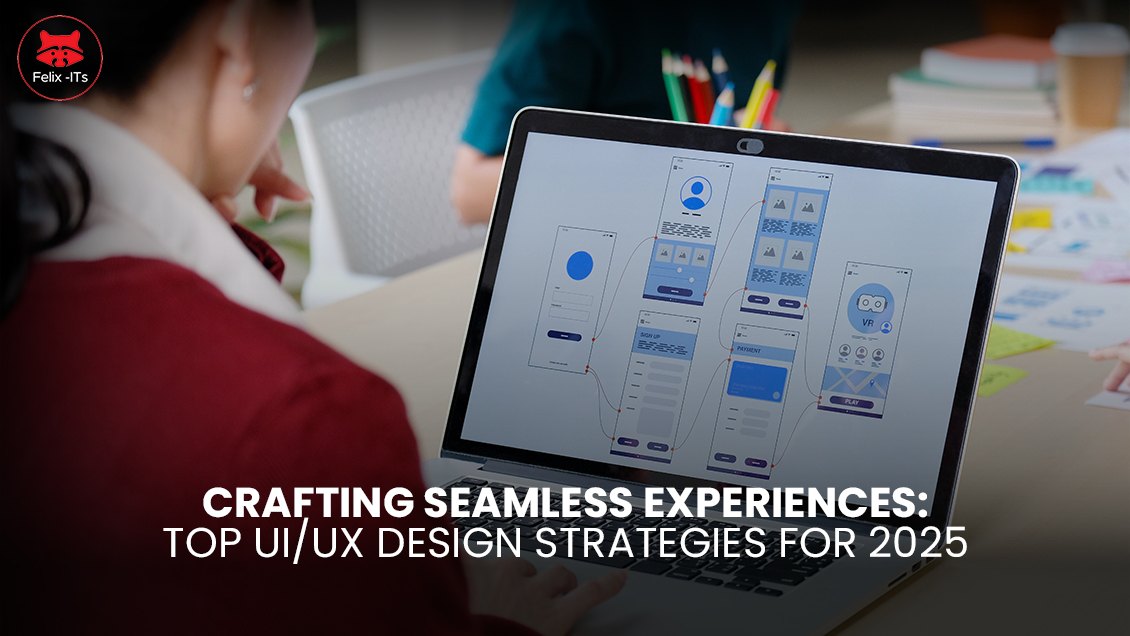User experience has to be a careful balance between usability and pleasing design that attracts the eye. Today, users expect seamless and visually appealing interactions while anticipating a personalized experience. Today, designers can experiment with cutting-edge UI/UX design strategies, ultimately leading to a usable experience while still giving joy.
In this blog, we will address actionable UI/UX design strategies that can have a lasting impression on your projects, including core aspects such as user interface design, UX design tips, as well as upcoming UI/UX design trends in 2025.
1. Committing to User-Centric Design
User-centric design signifies one of many substantial methodologies in UI/UX. On a very simplistic level, it is basically understanding the user’s journey, pain points, and goals and subsequently creating interfaces that speak directly to those needs of the user. The design process typically includes user research, surveys, and iteration processes where feedback from users helps designers see the project through users’ eyes.
User personas are an effective means of customizing the experience. “Think like the user” is a powerful mindset for the designer as he or she designs interfaces. Developing multiple personas allows the designers to see how different types of users might approach the same interface, giving added reassurance that the interface is indeed accessible and intuitive.
Takeaways:
- Conducting regular user testing helps catch compatibility issues from the outset.
- Create user personas to gain deeper insight into who your users are.
- Utilize journey mapping to understand user interactions and find improvement opportunities.
2. Embracing Minimalism and Visual Hierarchy
The trend of minimalism has been around UI/UX design for a long time and it ain’t going anywhere. A cluttered UI interface distracts users from important content, while with minimal design users can focus only on important things. Also, use a visual hierarchy that will guide the users’ eyes to the most important elements on the page.
A visual hierarchy can be established using contrast, size, color, and spacing. Calling out elements like CTA and navigation can keep users from panicking and getting lost.
Takeaways:
- Removing unnecessary elements and keeping the interface uncluttered
- Using contrast colors on CTAs for better visibility
- White space can be used to give the interface more breathing room
Additional Read – How to Successfully Land a UX/UI Design Internship in 2025
3. Developing for Mobile First Design
Considering the increasing mobile usage now and then, the primary focus of UI/UX design has been on mobile responsiveness. When UI/UX strategizing` digital products, it becomes important to focus on a mobile-first design, it helps in keeping the user experience the same across devices.
It outlines the responsive design, where you create all the layout that responds to things like screen size and include development and mobile UX thinking about touchpoint progress. This trend of 2025 is more likely to bring UI/UX designers into the loop to know the all recent trends of UI/UX.
Takeaway:
- Utilize flexible grids and media queries to help make everything responsive
- Reduce image size to improve load time
- Feature core content first, then display optional media items that can be slightly delayed to integrate correctly on a smaller screen
- Ensure buttons and touchpoints are large enough and easy to tap on mobile devices.
4. Microinteractions-Fostering Engagement
Microinteractions are tiny, interactive designs that assure users by providing feedback while guiding them to reach an objective. They may range from the color shift of a button upon being clicked, a success message punctual to the submission of a form, or simply displaying a small animated graphic that showcases an ongoing process so that the user does not get bored while waiting for something to happen.
The understated details, while perhaps minute in their portrayal of responsiveness, help to build an experience that is considered delightful.
Takeaway:
- Employ micro-interactions to signify a pending action, either through an error or as done.
- Ensure these do not endanger the interface with burdened responsibility or a slowed pace.
- Test with users to validate that the experiences are encouraging, minus the frustration.
Bonus Read – 8 Practical UI/UX Design Applications That Transform User Experiences
5. Prioritizing Ease of Use
Designing accessibly allows all users, including some with disabilities, to enjoy a seamless experience. Including certain accessibility features-for instance, providing alternative text for images, ensuring navigability with the keyboard, and the option to resize text-contributes to create a more inclusive design. Following such general accessibility guidelines as the Web Content Accessibility Guidelines (WCAG), designers can achieve a wider reach and fairer distribution of these experiences.
Accessible design is found to increase usability not only for everyone but also for brand reputation and market reach.
Takeaway:
- High contrast color scheme increases readability.
- All interactive elements must be keyboard-accessible.
- Have descriptive alternative text for images and labels for form fields.
Conclusion
Delightful user experiences hinge on adaptability, empathy, and informed originality. Designers who adopt these UI/UX design strategies along the lines of minimalism, micro-interactions, and personalization will create products that meet user requirements, often exceeding the user’s expectations. UI/UX design classes, whether taught independently or in colleges and institutes, can further sharpen one’s skills and keep him or her updated about current practices and trends.
As technology advances, user expectations will also keep increasing. By keeping abreast of this shifting landscape and choosing to embrace it, designers can produce delightful, unforgettable experiences that will engage users and instill satisfaction and loyalty in them.


